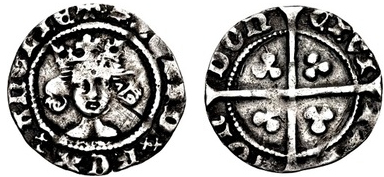The English Medieval Penny

The most widespread coin in use in medieval England was the penny. Twelve silver pennies made a shilling and there were twenty shillings to the pound. For transactions worth less than a penny it could be divided by physically clipping the coin into halves and quarters. Hence, half pennies and quarter pennies (known as farthings). Although official half pennies and farthings existed, they don’t ever seem to have been issued in the quantities needed to stop them being anything but rarities. The clipped coins therefore being the norm for anything less than a whole penny.
In accounting the Silver mark was used, although no actual mark coins existed. One mark was equal to 13 shillings and 4 pennies, which was two-thirds of one pound.
Wages and buying power in medieval England are notoriously difficult to estimate from a modern vantage point. There are so many unknowable factors at play that everything you can find on the subject can only ever be an estimate of what things cost on a daily basis.
I’ve assumed some typical daily earnings for the lower ranks of society for the time period my books are set in (1390’s – 1420’s) which I think are fairly accurate. A labourer, manservant, maidservant or swineherd might earn between one and three pennies a day. More skilled craftsmen like masons, carpenters, thatchers and weavers might earn between three and six pennies a day. A chantry priests might earn four pennies a day and an esquire or constable in the army perhaps thirteen pennies a day.
Cheap wine was about three pennies a gallon, the good stuff perhaps eight pennies a gallon. Ale, the staple drink of everyone, was three quarters of a penny for a weak gallon of ale and one and half pennies for a gallon of a better brew. Two dozen eggs could be had for a penny and you could buy two chickens for three pennies.